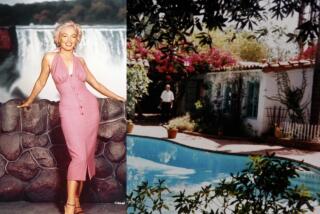Artist Rejects Beverly Hills Plan to Move Sculpture
- Share via
The creator of a controversial sculpture in Beverly Gardens Park has rejected an offer by the Beverly Hills City Council to move the artwork to a less visible location for the remainder of its scheduled exhibition.
In a letter to a City Council committee, George Herms, sculptor of “Moon Dial”--which consists of five rusted buoys surrounding a rusted mullioned window frame and a winch--said: “I cannot with a clear conscience accept the proposal to move the ‘Moon Dial.’ ”
The committee, made up of council members Allan L. Alexander and Vicki Reynolds, got involved in the controversy after numerous residents complained that the sculpture was ugly and inappropriately located in a corner of the park where North Palm Drive and Santa Monica and Beverly boulevards meet.
“Moon Dial” is part of a city Fine Arts Committee program to develop a sculpture garden in the 22-block-long Beverly Gardens Park. Under the program, artworks are commissioned by the committee but paid for by the artists. Each piece is displayed in the park for 18 months to 3 years. The city has the discretion to terminate the exhibition after 18 months.
Aggressive Program
For the city, the sculpture garden enhances an aggressive public art program. For the artists, the arrangement provides visibility for their works.
“Moon Dial,” installed in April, is the third work displayed as part of the program and the first to stir up debate. A petition with nearly 350 signatures was presented last month to the City Council objecting to “Moon Dial” and asking that the placement of public art be subject to a vote of the people.
In a letter dated July 20, the committee asked Herms to consider keeping the sculpture at its present site for a “shortened period of time to be mutually agreed upon by the parties involved.” For the balance of the exhibition period, the sculpture would be “relocated to an alternative site mutually agreed upon.”
The committee said it would then provide Herms with “the opportunity to appear in a television program for showing in Beverly Hills to discuss assemblage art in general and the ‘Moon Dial’ in particular.”
Proposal Rejected
Herms could not be reached for comment, but in a letter he sent to the committee last week, he rejected the proposal.
“In my view, any alternative site would not fit the nature of the work or address the formal concerns,” he said. “I certainly want this work to live and breathe in a pleasant environment.
“In order that new ideas may be openly embraced in the future, it behooves us to act with integrity in this matter. I think the city of Beverly Hills should honor its legal and moral obligation. I have honored mine.”
Alexander said he was disappointed that Herms chose not to accept the proposal but added that the City Council now has a “legal and ethical obligation” to allow “Moon Dial” to remain in place.
‘Want Traditional Art’
“I think (moving the sculpture) would have been the best solution,” Alexander said in an interview. “The people have said that they do not want avant-garde art in a public park. They want more traditional art.”
He said the sculpture would be more appropriate “in an area where people voluntarily come to view it,” such as La Cienega Park.
Although the Fine Arts Committee, the advisory board coordinating the development of the sculpture garden at Beverly Gardens Park, concurred with the proposal to move “Moon Dial,” its chairwoman said she was pleased that Herms rejected it.
“I, of course, stand behind Mr. Herms’ decision,” committee chairwoman Joan Agajanian Quinn said. “We made a contract with him. Besides, I like the artwork very much.”
Quinn said in an interview last week that too much is being made of the sculpture.
‘Other Problems’ Cited
“It is not a life-and-death situation,” she said. “We have so many other problems in Beverly Hills that we have to address. It is overreaction by people who have chosen to attack something where taste is involved, and where not everyone will be satisfied. This is something that will be up for a short period of time and that will involve art pieces that will be constantly revolving.
“There has been great support for George Herms in that many artists stand behind him and have told us that if Herms was removed, then they would not be a part of our exhibition.”
Quinn also said moving “Moon Dial” to a more private location would defeat the purpose of public art.
“Putting an art piece behind a gate or in an area where you had to enter to view it is not what public art is all about,” she said.
More to Read
The biggest entertainment stories
Get our big stories about Hollywood, film, television, music, arts, culture and more right in your inbox as soon as they publish.
You may occasionally receive promotional content from the Los Angeles Times.










